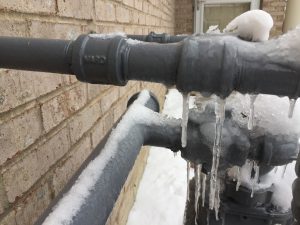How to Protect Pipes from Cold Weather Damage: Important Guidance
How to Protect Pipes from Cold Weather Damage: Important Guidance
Blog Article
The publisher is making a number of good points on the subject of Preventing and dealing with frozen pipes overall in this article down the page.

Winter can wreak havoc on your plumbing, especially by freezing pipelines. Below's how to avoid it from occurring and what to do if it does.
Introduction
As temperatures drop, the threat of icy pipes rises, possibly resulting in pricey fixings and water damage. Recognizing just how to avoid frozen pipes is critical for house owners in cold climates.
Avoidance Tips
Shielding vulnerable pipes
Wrap pipelines in insulation sleeves or use heat tape to protect them from freezing temperature levels. Focus on pipes in unheated or exterior locations of the home.
Heating methods
Maintain indoor spaces effectively warmed, particularly areas with pipes. Open cupboard doors to permit cozy air to distribute around pipes under sinks.
Just how to identify frozen pipes
Look for reduced water flow from taps, unusual smells or noises from pipelines, and noticeable frost on subjected pipes.
Long-Term Solutions
Architectural modifications
Think about rerouting pipelines far from exterior walls or unheated areas. Include added insulation to attic rooms, cellars, and crawl spaces.
Upgrading insulation
Invest in top quality insulation for pipes, attics, and walls. Proper insulation aids preserve consistent temperature levels and decreases the threat of frozen pipelines.
Securing Outdoor Pipes
Garden pipes and outdoor faucets
Disconnect and drain pipes yard hose pipes before winter months. Install frost-proof faucets or cover outdoor faucets with protected caps.
Understanding Icy Pipelines
What creates pipes to ice up?
Pipelines freeze when subjected to temperature levels listed below 32 ° F (0 ° C) for expanded durations. As water inside the pipelines ices up, it increases, taxing the pipeline wall surfaces and potentially creating them to break.
Threats and damages
Icy pipes can result in water supply disruptions, building damages, and expensive repair work. Burst pipes can flooding homes and cause substantial architectural damage.
Indications of Frozen Pipeline
Recognizing frozen pipes early can avoid them from breaking.
What to Do If Your Pipelines Freeze
Immediate activities to take
If you suspect frozen pipes, keep faucets open to eliminate stress as the ice melts. Use a hairdryer or towels taken in warm water to thaw pipes gradually.
Final thought
Avoiding frozen pipelines requires aggressive procedures and quick feedbacks. By comprehending the causes, indications, and preventive measures, home owners can safeguard their pipes during winter.
6 Proven Ways to Prevent Frozen Pipes and Protect Your Home
Disconnect and Drain Garden Hoses
Before winter arrives, start by disconnecting your garden hoses and draining any remaining water. Close the shut-off valves that supply outdoor hose bibs and leave the outdoor faucet open to allow any residual water to drain. For extra protection, consider using faucet covers throughout the colder months. It’s also important to drain water from any sprinkler supply lines following the manufacturer’s directions.
Insulate Exposed Pipes
Insulating your pipes is an effective way to prevent freezing. Pipe insulation is readily available at home improvement stores and is relatively inexpensive. Pay close attention to pipes in unheated areas such as the attic, basement, crawl spaces, or garage. Apply foam insulation generously to create a buffer against the cold. You can also wrap your pipes in heat tape or thermostat-controlled heat cables for added warmth.
Seal Air Leaks
Inspect your home for any cracks or openings that could let in cold air. Seal any holes around the piping in interior or exterior walls, as well as the sill plates where your home rests on its foundation. Additionally, make sure to keep your garage door closed unless you’re entering or exiting. Leaving it open creates a significant air leak that can lead to frozen pipes.
Allow Warm Air Circulation
During cold snaps, it’s essential to allow warm air to circulate evenly throughout your home. Leave interior doors ajar to promote better airflow. Open kitchen and bathroom cabinets to help distribute heat consistently around the rooms. If you have small children or pets, be sure to remove any household chemicals or potentially harmful cleaners from open cabinets for safety.
Let Faucets Drip
A small trickle of water can make a big difference in preventing ice formation inside your pipes. When temperatures drop significantly, start a drip of water from all faucets served by exposed pipes. This continuous flow helps prevent the water from freezing. Additionally, running a few faucets slightly can relieve pressure inside the pipes, reducing the chances of a rupture if the water inside does freeze.
https://choateshvac.com/6-proven-ways-to-prevent-frozen-pipes-and-protect-your-home/

I am just very occupied with How To Avoid Freezing Pipes and I'm hoping you appreciated my post. Do you know about anybody else who is occupied with the topic? Feel free to promote it. I cherish reading our article about How To Avoid Freezing Pipes.
Quote & Schedule Report this page